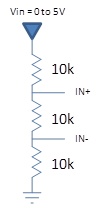Dear experts.
I want to use the DRV on my PCB. I read all documents and managed to be confident with most additionaly required parts, but there are some question left:
1) Inductor: there is no equation or so. How to choose a value? Is it experience? I have none ;) My application will be less than 1A; I found 3.3µH and 4.7µH in the documents. But there is even more possible (up to 22µH).
2) Boost Capacitor: Same as question 1. Just take a 100nF capacitor and that´s it?
3) In the "Piezo Speaker Strobe Notification Reference Design" there are 0.1µF and 1µF capacitors at the VDD and BST pins. (Why) is the 1µF necessary? In the datasheet it´s only 0.1µF.
4) I connect the piezo between OUT+ and GND. Should the OUT- remain open, or be connected to GND via a capacitor like an unused IN-pin?
5) Figures 9 to 12: I am still not clear about the Vin, Vout and gain. Figure 9: the Vpp is 50V (+/-25V). the Vin is 1.8V (+/-0.9V). Correct?
Thanks a lot again for your patience and support!!!
Sebastian



